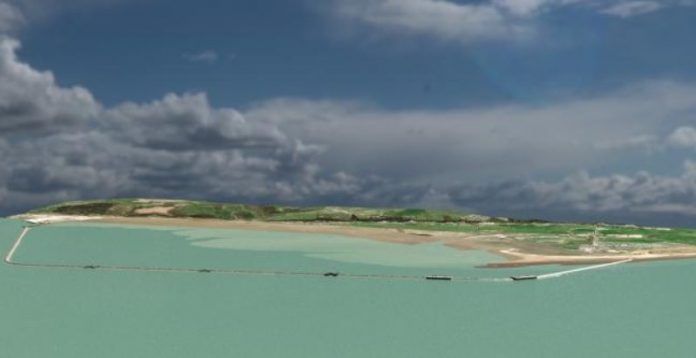Plans have been revealed for a £590m tidal lagoon capable of providing low carbon electricity to power 82,000 homes in North Wales
Building the 6.7-kilometre tidal long lagoon, stretching from the breakwater at Mostyn to Point of Ayr in Flintshire, would create 300 jobs during the construction phase and up to 30 skilled permanent posts.
Developed by Mostyn SeaPower Ltd, a subsidiary of the Port of Mostyn, the tidal lagoon could provide a massive boost for the regional economy and play a key role in helping North Wales to recover from the Covid-19 crisis.
The company will be using local labour and suppliers wherever possible.
As a relatively small scale renewable energy development, it’s expected the scheme can pave the way for larger tidal power projects at other locations along the Welsh coastline with suitable tidal variations.
The Dee Estuary has one of the highest tidal movements in the UK, as much as 10.2 metres during high spring tides, as well as having natural deep water for the installation of the turbines.
The tidal lagoon wall will be two metres above sea level and will provide much-needed flood protection for the low-lying land along the coast which includes homes and businesses, the A548 Coast Road and the North Wales coast railway line.
It will have two sets of turbine houses with three sluice gates to control the volume of water over the tidal cycle, along with lock gates allowing small vessels in and out of the sheltered lagoon.
In total there will be eight 16 megawatt turbines which will generate 298 gigawatt-hours of electricity annually.
The tidal lagoon wall will have a road running along the top and a path that will be accessible to the public.
Preparatory work, including environmental and ecological studies, has been taking place for four years and the lagoon will be designed to maintain navigational access for shipping.
Mostyn SeaPower has been working with engineering consultants BAM Nuttall and environmental experts ABPMer.
The company has already negotiated with the National Grid for the electricity to be used by the nearby Connah’s Quay Power Station.
It is planned to submit an application to the UK Government for a Development Consent Order by the end of 2022.
A boost for the regional economy
Jim O’Toole, managing director of the Port of Mostyn, said: “The construction time for the lagoon wall, turbine housings and sluices will take approximately four years.
“Manufacturing of the turbines will take two years to complete and will be carried out in conjunction with the wall construction.
“The turbines will be assembled at the port and will be installed simultaneously with the lagoon wall.
“As each turbine is tested and commissioned it will be connected to the grid. First power is expected to be delivered to Connah’s Quay in mid-2027 and project completion by the end of that year.
“During the construction phase in the order of 300 jobs will be created at the port and further employment will be secured in local companies providing quarrying, mechanical, electrical, hydraulic, steel supply and fabrication services.”
Pave the way for larger scaled projects
O’Toole added: “This will be the biggest infrastructure project North Wales has seen for a very long time and it will provide a massive and timely boost for the regional economy to kick-start the recovery from the economic downturn caused by the coronavirus pandemic.
“During the long term operational phase, the project will directly employ between 25 and 30 local people in highly skilled positions with a further five or six people indirectly employed in supporting services.
“Since inception of the project four years ago there has been rapid advances in renewable energy generation.
“In particular, battery storage, hydrogen production and liquid air battery technologies have all developed to the extent they now offer opportunities to enhance the operational and commercial viability of tidal lagoons.
“We will therefore continue to keep abreast of these technological advances and should opportunities arise during the design stage we will look to incorporate them in the Mostyn project.
“The relatively small scale of the Mostyn SeaPower project will pave the way for future larger scaled projects around the Welsh coast.”
The turbines could be turning and producing energy by mid-2027.














